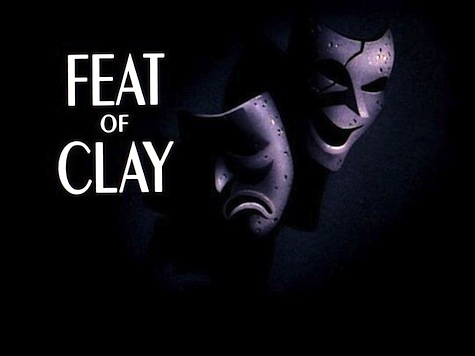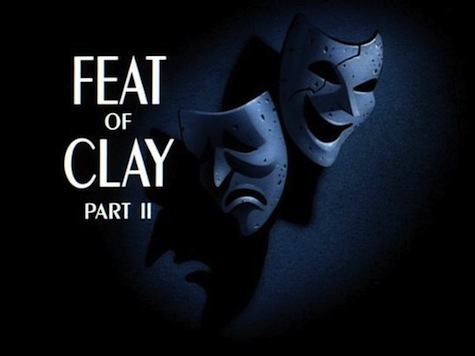“Feat of Clay: Part 1”
Story Marv Wolfman & Michael Reaves
Teleplay Marv Wolfman
Directed by Dick Sebast
Episode #020
Supervising Composer Shirley Walker
Music Composed by Jeff Atmajian, Carl Johnson
Animation Services by Akom Production Co.
Original Airdate – September 8th, 1992
Plot: Horribly scarred actor Matt Hagen is addicted to ReNuYu, a cream that allows him to look like anyone. Industrialist Roland Daggett blackmails Hagen into framing Bruce Wayne but then Hagen tries to steal the ReNuYu so Daggett’s goons bury Hagen in the cream… with unforeseen consequences.
There are several Clayfaces in the comics, and the Animated Series version is a mash-up of the first two. This guy has the backstory of being a tragically disfigured film star from the first Clayface, Basil Karlo, and the name and powers of the second Clayface, Matt Hagen. Tying his powers to a corrupt businessman and an addiction narrative, rather than a magic cave, brings Clayface in line with the rest of The Animated Series by being revenge-oriented and science fictional. That said, we didn’t need a whole episode to explain who he was before he was made of clay.
“Feat of Clay: Part 1” is just so boring. The comparison is to “Two-Face: Part 1,” but instead of watching Harvey Dent, a good man and friend of Bruce Wayne, destroyed by inner demons and corrupt forces, Matt Hagen is barely in this episode, only two scenes where he is himself, and what we see is not very positive.

Hagen is violent, vain, selfish, impetuous, and abusive to Teddy, his best friend, stand-in, and roommate. In fact, Teddy so much plays Grace to Hagen’s Dent that I’m going to go out on a limb and say Teddy is Hagen’s boyfriend, something that could only be implied rather than stated on a children’s show in 1992 (see Maggie Sawyer on Superman: The Animated Series). Teddy says it’s Matt’s addiction to ReNuYu that makes Matt act horribly, but as we never saw Matt before his disfiguring accident, we have no reason to believe him. Matt’s a pretty unlikeable person, and it doesn’t feel like a tragedy when he’s turned into a puddle of goo at the end.
And instead of making us like Hagen before his destruction, most of the episode follows Batman’s assbackward attempts to clear Bruce Wayne. A good third of the episode is given over to a chase sequence where Batman flies his Batplane through a tunnel in order to impale a car and interrogate the driver. The entire sequence is boring (there’s no doubt that Batman’s super-plane can chase down a normal car), morally appalling (how many lives did Batman endanger before physically torturing Daggett’s luckless thug), and in the end pointless since the guy passes out before saying anything anyway. Add to that sneaking into Lucius Fox’s hospital room as Bruce Wayne, only to get arrested, and you start to wonder if Batman bought that “World’s Greatest Detective” mug for himself.
All of the major problems in this episode are with the script, which I find surprising since it was written by veteran comics and cartoon writer Marv Wolfman. I can only surmise this, but it feels like the much better Part 2 was supposed to be a single episode, it ran long, and Wolfman tried, and failed, to expand the episode out to a two-parter. But that’s only a guess.
“Feat of Clay: Part 2”
Story Marv Wolfman & Michael Reaves
Teleplay Michael Reaves
Directed by Kevin Altieri
Episode #021
Music by Shirley Walker
Animation Services by Tokyo Movie Shinsha Co., LTD.
Original Airdate – September 9th, 1992
Plot: Batman closes in on Daggett as the man who framed Bruce Wayne. But doing so bring him face to face with Clayface, a shapeshifting monster who’s out for his own revenge.
In contrast to “Two Face” and “The Cat and the Claw,” the second episode of “Feat of Clay” is vastly superior to the first half (though, like “The Cat and the Claw,” the better episode is directed by Kevin Altieri). For one thing, we finally get Clayface as a villain instead of a victim, and hoo boy he is fantastic.
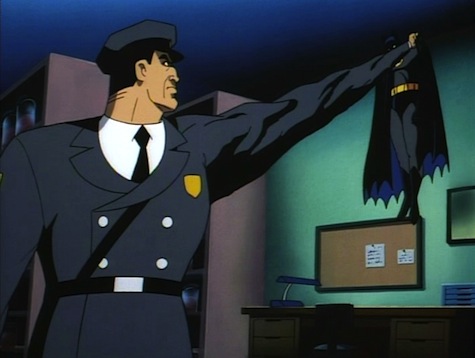
For one thing, he’s voiced by Ron Perlman, and as I said before, Ron Perlman’s awesome. His performance here is wonderfully nuanced for such an appropriately melodramatic character. His mood swings from depression to elation as he realizes he has godlike powers, only for his inner jerk to re-emerge when he thinks his powers aren’t good enough, reveal a complicated and terrible person given ultimate power. Clayface’s confession that he always wanted to play a a great death scene is heartbreaking, until you watch this episode a second time and know that he’s lying, at which point it becomes awesomely dickish. Perlman, like Hamill, captures the sick joy villainous power brings.
And man is Clayface powerful. He is probably Batman’s most dangerous villain in the entire series. On top of being able to look and sound like anyone, a terrifying, paranoia inducing power on its own, Clayface is also a giant mudslide that steamrolls Batman for 22 minutes straight. Wolfman and Reaves foregroud Clayface’s offensive capabilities and make him a more animation friendly villain (clearly influenced by the T-1000 from 1991’s Terminator 2) but they so improved Clayface’s abilities from his comics version that they took a Batman villain and made him a Superman villain. Punches, kicks, falls, batarangs, and electricity have no effect whatsoever. (If only Batman could “freeze” Clayface somehow, maybe with a “freeze” gun of some kind, but where would Batman get something like that?)
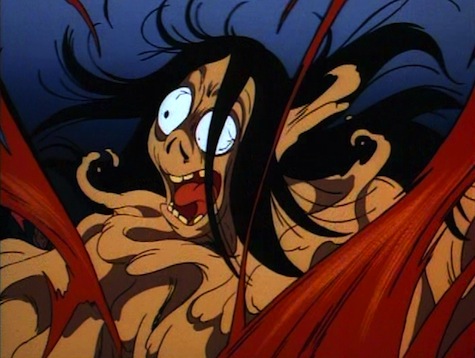
Clayface’s animation is the highlight of the show. Altieri’s direction creates some fantastic visuals, but most of the credit goes to Tokyo Movie Shinsha Co, who deliver one of the most fluid and wild animation jobs of the entire series. While fighting, Clayface has a heavy presence, so each impact lands just as hard on the viewer as on Batman. But when shifting his face, from human to muddy and back, or his insane self-destructive death spiral, spinning wildly between his forms, his face tearing apart again and again, the painful, grotesque images are mind-blowing. And his transformation at the end, from a large angry woman who bursts into a giant monster, is possibly the best entrance of a character in the show.
Besides Perlman, this episode has two other great guest voices from a couple of Eds. Ed Asner voices Roland Daggett, who will be a reoccurring villain throughout the series, basically whenever the script calls for “generic evil business man” (just as Rupert Thorne is called in when they need “a mob boss”). Daggett is who Ferris Boyle would be if Boyle didn’t even pretend to be humane. Though the character is officially original to The Animated Series, in character and appearance he greatly resembles Norman Osborn, the civilian identity of the Green Goblin.
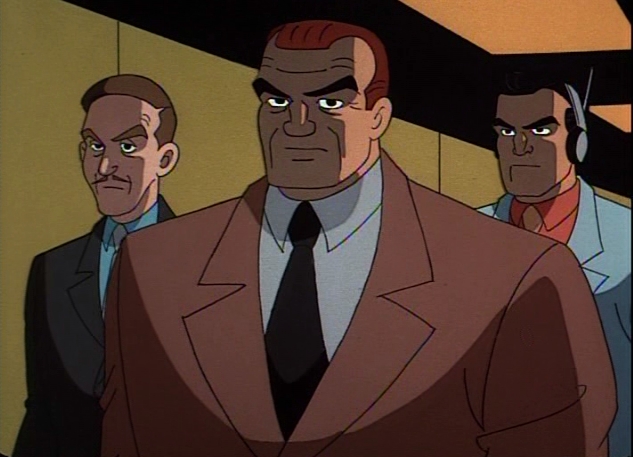
The other great job is by Ed Begley Jr, as Daggett’s germophobic right hand man. The interrogation scene where Batman places a jar of water over his head and claims it’s some horrible disease works mostly because of Begley’s delivery. He tries so desperately to be brave in the face of both Batman and an unspeakable infection that it’s very satisfying when he breaks. It also makes a great contrast to the interrogation in Part 1, where Batman couldn’t do with an experimental jet what he does here with a small jar of H2O.
The only real problem with “Feat of Clay: Part 2” is that there’s no reason for Clayface to have faked his death. If electricity has no effect, why doesn’t he just keep going and eventually kill Daggett? We’re supposed to believe that seeing multiple versions of himself made Clayface lose control, but he actually had enough self-control to make a fake body for himself and then slip away when no one was looking. Even if you accept that he had to escape at that moment, if he’s still alive then he should still be trying to kill Daggett. Instead he just laughs, specifically the jerk laughs at Teddy, who is mourning him. I know it’s supposed to set up his inevitable return, but mostly it just unresolves the plot. And that’s… annoying.
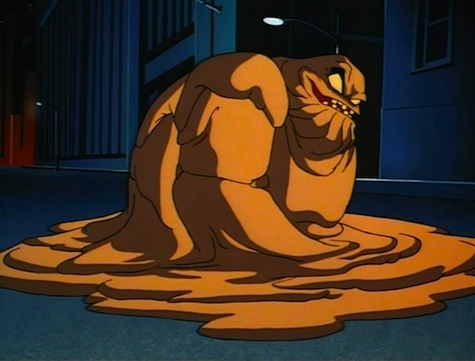
Steven Padnick is a freelance writer and editor. By day. You can find more of his writing and funny pictures at padnick.tumblr.com.










